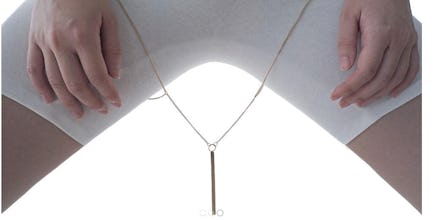"Thigh Gap Jewelry" Is an Unexpectedly Woke Statement On Bullshit Trends

The thigh gap, or the space "thin" girls have between their thighs when their knees are together, has always been a problematic trend, encouraging women to value an even more impossible than usual beauty standard (and that's saying a lot in today's world).
Enter the solution we never knew we needed: thigh gap jewelry, or TGap. No, it's not just a way to bedazzle your inner thighs. Singapore designer Soo Kyung Bae created the fake product as a creative way to call out unrealistic body expectations that girls face every day.
Read more: There's a New Trend Replacing Thigh Gaps — And It's Something We Can Actually Get Behind
The TGap Jewellery website looks like any other retailer site, but with an "About" page stating, "TGap Jewellery designs accessories specifically for thigh gap." However, when you go to add the product to your cart and attempt to purchase, the website redirects you to a new website with the true story behind TGap Jewellery.
"TGap Jewellery is a fictional company that sells jewelry designed for thigh gaps," the real website states. "It is launched to catalyze a debate on unrealistic body image social media portrays."
The website further explains how some women intensely diet in order to get a "thigh gap," even though having one is typically based on your bone structure, not just your weight.
Commenters on the website seem to like Bae's approach of addressing negative body stereotypes.
"I think it's a fresh concept that nobody has tackled so far, and it's a creative way to go about it in the sense that it leads girls to question the issue themselves," one commenter wrote.
"A clever way to send message about body image issues today. I am one of the many victims whose body image is affected by media," another wrote.
Although thigh gaps aren't a new "trend" (it started making waves in 2013), many are still posting on social media about working to get one with the hashtags #ThighGaps and #Thinspo. Recently, Amy Schumer was criticized for calling out Taylor Swift's thigh gap, which could be considered another form of body-shaming.
"Body shaming bitch!! You're part of the problem. Everyone should feel comfortable in their own skin," a commenter wrote.
"Thigh gap represents one of the first trends regarding body ideals the media has popularized," Bae told Dezeen. "It clearly demonstrates media's power on influencing one's perception of body image."
Bae is, in a way, trolling the thigh gap phenomenon. But it's body "trends" like the thigh gap — negative and unhealthy ones that just don't seem to disappear — that can benefit from creative solutions.
"One can use design to spark debate and reflection, to be a catalyst for people to decide for themselves about their position on this matter," Bae told Dezeen. "I hope it leads to more people-centred, people-loving conclusions, but it is for the audience to decide for themselves."
h/t Dezeen